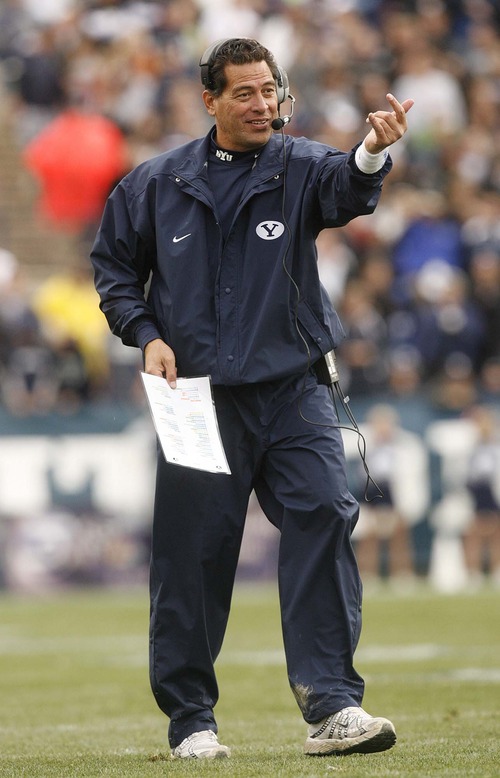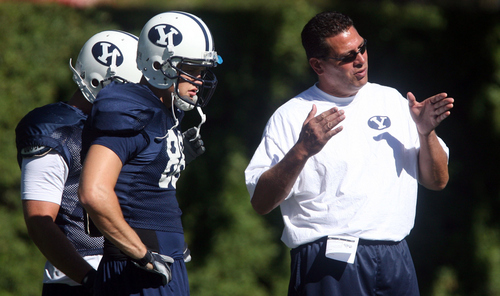This is an archived article that was published on sltrib.com in 2013, and information in the article may be outdated. It is provided only for personal research purposes and may not be reprinted.
Provo • Headed out of the Student Athlete Building after practice and meetings Friday night, BYU offensive coordinator Robert Anae met me in the middle of the stairway.
Thanks for the symbolism.
"Nowhere near satisfied," Anae said, summarizing a season that will end with Friday's Fight Hunger Bowl vs. Washington in San Francisco. "Halfway, maybe."
That might be a modest assessment. BYU's offensive performance overcame some of my doubts about Anae's return to Provo, after I questioned coach Bronco Mendenhall's unusual management approach — much like my issues with Kyle Whittingham's continual realignment of Utah's offensive staff, only different.
Mendenhall rehired Anae after two seasons at Arizona and brought in four new offensive coaches. Three had never worked at the FBS level. Anae declared he had come back to his old job with "the intent to prove something."
And his offense achieved something, but not everything. During a regular season when BYU ranked 14th in the country in total offense, the story kept changing, that's for sure.
If the Cougars are judged by their high of 17 points in losses to Virginia, Utah, Wisconsin and Notre Dame, their story is the same, old tale. Against other opponents, BYU's fast-paced, run-oriented offense appeared overwhelming at times, with 1,000-yard rushing seasons for running back Jamaal Williams and quarterback Taysom Hill. Then there's the dilemma of how to view the Cougars' performance against Texas — as an illustration of what this offense can do, or as an aberration against a messed-up defense whose coordinator was fired the next day.
Subjectively, according to the endorsements of Mendenhall and team leader Eathyn Manumaleuna, Anae succeeded.
"The team is united, from expectation, effort, toughness, practice standard, commitment — and the staff is united," Mendenhall said.
"There's a big distinction between this year and last year," said Manumaleuna, a defensive lineman.
Objectively, BYU's problem is the same as ever. In their eight wins, the Cougars averaged 39.6 points and 544.2 total yards, while allowing 19 sacks. In four losses, BYU averaged 14.8 points and 397.5 yards, giving up 14 sacks.
The tidy summary is the Cougars were good, except when they faced good defenses. "That's no excuse," said Hill, blaming BYU's own performance.
In contrast, the defense's statistics were nearly identical in wins and losses — although those numbers are somewhat skewed by a dominant performance at Virginia.
The Cougars used 11 starters at the five offensive line positions and dealt with injuries at receiver and tight end. BYU's starting linemen for the Fight Hunger Bowl include three juniors, a sophomore and a freshman. Hill and Williams are sophomores and junior college transfer Nick Kurtz could be a dynamic receiver, so the offense is positioned to have a big 2014 — with an easier schedule.
"We improved tremendously and I can't wait for next year," Williams said. "It's going to be second nature for us."
Senior receiver JD Falslev said, "I think it's going to turn into something very, very special. [Anae's] got such a great football mind, he motivates kids very well, he surrounds himself with great coaches."
Anae hopes a good performance against Washington will leave a favorable impression of the offense in 2013, and then he'll work on BYU's deficiencies: protecting the passer, converting third-down plays and finishing drives.
"I'm more driven than when we started this, because I do see the potential," Anae said. "I foresee that we can be much, much, much better than we are."
Twitter: @tribkurt





